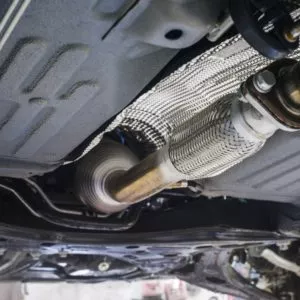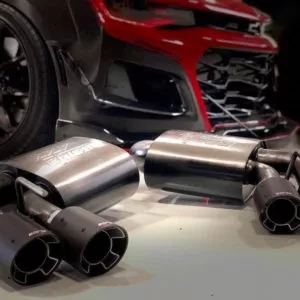There are a lot of ways people can change their vehicle’s exhaust sound. Some might want their vehicle’s exhaust to be as loud as possible. Others just want to give their vehicle’s exhaust note more character without being too loud. On the other hand, some people might want to strike a balance between sounding great and not being too loud. Whatever people’s preference for exhaust noises is, they’ll need certain parts to improve their vehicle’s current exhaust sound.
In this article, we’ll give you a list of car exhaust parts and talk about which parts can make your exhaust sound louder and which parts can give your exhaust better acoustics.
Header
Headers are the metal tubes that lead exhaust gases out of each engine cylinder. Headers also play a key role in the engine’s sound, since this is the first exhaust system part that facilitates exhaust gases. Wider header tubes can create a deep and throaty exhaust note, while narrower tubes can make the exhaust sound higher-pitched.
Choosing your header’s material is important because the header plays a big role in your vehicle’s exhaust note and the engine’s acoustics. Generally speaking, stainless steel exhaust parts create a clean and high-pitched metallic noise. One way to describe it is like how aluminum cans reverberate sound. Meanwhile, steel exhaust parts create a deeper tone. Headers are also generally louder than a vehicle’s stock exhaust manifold.
When upgrading your header, ensure that it doesn’t make your exhaust note so loud that it violates your area’s noise laws. Otherwise, you risk getting a noise ticket.
Keep in mind that not all vehicles can accommodate aftermarket headers because the catalytic converter is part of the exhaust manifold.
Many modern vehicles can’t accommodate aftermarket headers due to the catalytic converter being part of the exhaust manifold.
–Anthony Harlin, ASE Certified Master Automobile Technician
Muffler
Your vehicle’s stock muffler is made to lessen the volume of your engine’s exhaust sound. Mufflers are full of metal plates and chambers that absorb the engine’s sound waves. Going for an aftermarket muffler can lessen the muffling effect since it tends to be more hollow.
Muffler Delete Pipe
One way to make your exhaust significantly louder is to delete the muffler completely. A muffler delete pipe is needed to replace the gap in the exhaust system. Removing the plates and chambers that muffle sound also allows exhaust gases to freely flow out, which can also improve performance.
Resonator
A resonator is like a second muffler. However, the resonator is meant to alter the exhaust note by removing sounds from a particular frequency rather than lessening the exhaust volume. The resonator is meant to remove high-pitched noises such as hums and buzzes. Choosing a different resonator can make your exhaust sound different since the new muffler can target different frequencies and bring out a different sound. You can also choose to remove your vehicle’s resonator if you prefer to make your vehicle’s exhaust as loud as possible.
Exhaust Tip
Do exhaust tips change a vehicle’s sound? Absolutely. Despite being the last piece of piping along the exhaust system, the exhaust tip still plays a role in defining your exhaust’s sound. Exhaust tips with smaller holes reduce noise levels by restricting exhaust gases. Meanwhile, larger exhaust tips tend to create a deeper and louder sound because the tips don’t restrict the gases.
Complete Exhaust System
Instead of replacing individual components, one way to drastically change your vehicle exhaust sound is to get a complete exhaust system. Aftermarket exhaust systems have larger diameter tubing that’s meant to increase airflow. This will make your exhaust louder and drastically change your vehicle’s exhaust note.
You can get a cat-back or axle-back exhaust system. Cat-back exhaust systems replace everything behind the catalytic converter. Meanwhile, axle-back systems are cheaper and only replace everything behind the rear axle. If you’re focused on getting a better-sounding exhaust, cat-back systems tend to have a more profound impact on sound.
Notes Before Replacing Exhaust System Components
Some states might have noise ordinance laws that prohibit vehicle exhausts from exceeding a certain decibel limit. For example, California prohibits people from making any modifications meant to increase their vehicle’s exhaust noise. All vehicles under 6,000 pounds are also not supposed to make noises louder than 95 decibels. If you plan on upgrading your vehicle, make sure that your vehicle can comply with your state’s laws, or else you’re going to have problems registering your vehicle.
If you plan on upgrading your exhaust components, you won’t know what your exhaust will sound like until after you’ve installed the parts and revved your engine. There are a lot of variables that play a role when it comes to engine sound, hence it’s quite difficult to predict what an engine will sound like after changing exhaust components. That said, you can try to look for videos of other vehicle owners installing similar components in their vehicles to have an idea of how your vehicle will sound.
Any information provided on this Website is for informational purposes only and is not intended to replace consultation with a professional mechanic. The accuracy and timeliness of the information may change from the time of publication.




















